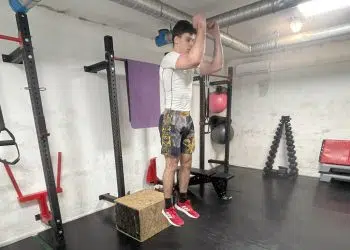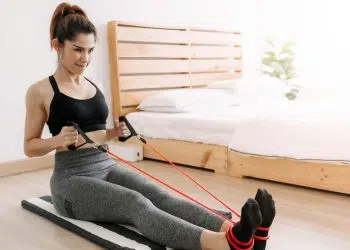If there is one thing I consistently notice lacking in most bodybuilding and powerlifting training programs, it is plyometrics training. Plyometric training, also known as jump training, involves exerting maximum muscle force in short intervals with the aim of increasing total power output.
Plyometric (plyo) training uses the muscle fibers’ stretch-shortening cycle (SSC) to boost physical capacity. It involves pre-stretching a muscle followed by a strong muscle contraction. Imagine getting ready to jump on top of a box by bending your knees, hinging at the hips, and driving your hands behind your body, followed by an explosive knee and hip extension and swing of the arms. Plyo training is one of the best ways to build explosive power, improve your athletic abilities, and boost overall fitness. (1)
Considering all the benefits plyometric training offers, plyo boxes deliver the best bang for your buck. That is, however, if you build your own plyo box. High-quality commercial 3-in-1 plyo boxes cost north of $75, plus shipping and taxes, which, if you ask me, is too high for a wooden box.
The good news is that DIY plyo boxes are relatively easy to build, even for folks with zero prior experience with power tools, and cost you less than $35. In this article, we cover everything you need to know to build a robust 3-in-1 plyo box.
Materials & Tools Required
Here are the tools and materials you will need to build the DIY plyo box:
- One 8′ x 4′ piece of plywood that’s 3/4″ thick
- Skilsaw or table saw
- Drilling machine
- Measuring tape and straightedge
- Marker
- 2″ wood screws
- Wood glue
- Orbit sander
- Paint (optional)
How To Build the DIY Plyo Box

Level Up Your Fitness: Join our 💪 strong community in Fitness Volt Newsletter. Get daily inspiration, expert-backed workouts, nutrition tips, the latest in strength sports, and the support you need to reach your goals. Subscribe for free!
This is the step-by-step guide to crafting a 28″ x 24″ x 20″ plyo box:
Step One — Get the Material & Cut It
Purchase the 8-foot by 4-foot plywood from your local hardware store. Alternatively, you could get it from an online store. This piece of plywood is big enough to carve out six wooden pieces of appropriate sizes.
Place the plywood on your work table and mark:
- 2 x 28 by 20-inch boxes
- 2 x 28 by 22.5-inch boxes
- 2 x 22.5 by 18.5-inch boxes
Use a marker, measuring tape, and a straightedge to draw the rectangles. Then, use a table saw to cut the wood.
Folks who don’t have access to power tools should purchase pre-cut plywood. Alternatively, you could get the hardware store to cut the wood for you. Getting pre-cut wood might cost you a few extra bucks, but it saves you a lot of time, which makes it worth it.
Begin cutting the wood from the sides. Cut the spare wood off after each rectangle is detached. This will make cutting the remaining rectangles easier.
Pro Tip: Use a thick red marker to draw the boxes. Draw full boxes instead of just marking the corners. This way, you will have clear reference points while cutting the wood.
Step Two — Test Assemble the Box
Irrespective of whether you are a carpenter or a beginner, you must do a preliminary assembly to ensure all the box pieces fit together perfectly. Joining uneven pieces will lead to instability, which could result in injuries during a workout.
Begin the test assembly by placing a 22.5 by 18.5-inch rectangle piece on the floor. This piece is the smallest piece of the box and will be encased by the four bigger pieces. Place the 28 by 20-inch pieces on opposite sides of the bottom. The 28-inch sides must point up, and the 20-inch sides should be placed against the 18.5-inch side on the floor.
Add the 28 by 22.5-inch pieces to the remaining sides of the bottom rectangle. The 28 by 20-inch sides should be flush with the bigger sides.
If the wood pieces do not align, recheck the rectangle dimensions using a measuring tape. Use a table saw to make the necessary adjustments.
Pro Tip: Keep the correction cuts small, or else you will have to buy a new piece of plywood to complete the box. Be conservative with the adjustments and take your time with this process.
Step Three — Attach the Plyo Box Using Glue and Screws
Once you’re happy with the plyo box, it’s time to bolster everything together. Apply wood glue to all the points where wood touches wood. Be generous with the application. You can always wipe off the excess glue later.
Remember, you must work one piece at a time. Wood glue can take up to 15 minutes to dry. This process might be slow, but you must allow the wood glue enough time to set for optimal durability.
Drill through the adjoining wooden pieces from the sides at 5 inches apart. Ensure that you’ve covered most of the box. Also, drill pilot holes before adding the screws to avoid cracking the plywood. Cracks can significantly hamper the box’s sturdiness.
Level Up Your Fitness: Join our 💪 strong community in Fitness Volt Newsletter. Get daily inspiration, expert-backed workouts, nutrition tips, the latest in strength sports, and the support you need to reach your goals. Subscribe for free!
Step Four — Sand the Edges
If I got a dollar every time I saw someone bump their shins into a plyo box, I could have built at least three DIY boxes by now. These things are unforgiving, and you must ensure you are doing everything you can to lower your chances of injury. That said, the first thing you must do is smooth out any rough edges. Also, feel free to blunt the sharp edges with the sander.
Step Five — Test
Let the box sit for at least a couple of hours to allow the glue enough time to set. Then, you are clear to begin testing it. However, you shouldn’t start jumping on it right away. You want to begin by simply sitting on it and moving around. Then, take it up a notch by standing and gently jumping on it.
Pro Tip: More cautious individuals can use a sandbag for testing their plyo box. Drop a heavy sandbag on the plyo box until you’re satisfied with its sturdiness. However, avoid using weight plates, dumbbells, or kettlebells for this test. You don’t want to dent or crack the plywood.
Step Six — Paint
Although this step is optional, I highly recommend you do it. After your DIY plyo box is ready, use paint to indicate the length with an arrow pointing in the correct direction. I know what you’re thinking. “This isn’t rocket science. The biggest side is the longest, and the smallest is the shortest.” Right, but good luck remembering the length of the longest side while you are in the middle of a brutal metcon. Just mark the box, and thank me later.
Safety Considerations While Building a DIY Plyo Box
Here are the things you must consider while crafting a plyometric box:
Use Proper Gear While Building the Plyo Box
Safety (while training or building DIY equipment) should be your first priority. Use goggles and gloves while using power tools. Also, you must adhere to the tool’s safety manual. Take your time with building DIY projects. Rushing through them can hamper their durability and expose you to a risk of injury.
Always Jump High
The edges of a wooden plyo box are brutal. Standing too close to the box or not jumping high enough can lead to injuries. The chances of injury skyrocket when you are fatigued. If you can no longer jump high enough, it’s better to take a breather before resuming the exercise. Alternatively, you could topple over the box and jump onto a shorter side if you don’t want to compromise your training intensity.
Pro Tip: Invest the time in learning the correct box jump technique. Using an incorrect form can lead to lower body joint pain. Remember, how you get off the box is as important as how you get on it. Most ankle sprains happen during the dismount.
Install Corner or Edge Protectors
Using edge protectors on the plyo box is one of the best ways to avoid scraping your shins. It is a must-do if your kids will be using the plyo box. However, you must be diligent with adding the corner protectors, as an incorrect installation can throw it off balance.
Avoid Keeping Your DIY Plyo Box Outdoors
Since this DIY plyo box is made of wood, you should avoid leaving it outdoors. Letting it sit in the rain, snow, and direct sunlight can impede its longevity. Also, you must routinely check your DIY training equipment for signs of wear and tear. Repair any defect as soon as possible to ensure durability.
Benefits of Plyo Box
Adding a plyo box to your training regimen entails the following benefits:
Consistent Challenge
Burpees are a form of plyometric training. However, the problem with burpees is that most people cheat on this exercise by skipping the jumps as fatigue begins to set in. This is not possible in box jumps. A plyo box sets the bare minimum effort an athlete must put in while doing this exercise.
Use as a Utility Bench
Folks with limited space in their home gyms can use the plyo box as a utility bench for exercises like the seated dumbbell curl, shoulder overhead press, and side lateral raises. Heck, I have also seen people perform dumbbell bench presses on a plyo box. You could do so by placing your upper and mid back on the box while keeping your hips elevated off the floor. Besides the chest, this variation engages your core.
Increase Your Power, Explosiveness, and Speed
Box jumps are one of the most effective plyometric exercises. An MDPI study found that “plyometric training increases vertical jump performance, strength, horizontal jump performance, flexibility, and agility/speed.” (2)
Full Body Workouts
Contrary to what most people believe, you can use plyo boxes for training the upper body. Besides their intended use, plyometric boxes can be used for incline or decline push-ups, dumbbell bench presses, and overhead presses.
Fairly Easy To Build
Whether you purchase a plyo box from a big company or build it yourself in your backyard, the tools and steps involved will mostly be the same. Plyo boxes are one of the easiest DIY training equipment to produce; even beginners can build them. Building a DIY box will also give you the confidence to tackle bigger and more challenging do-it-yourself projects.
FAQs
Is a DIY plyo box as sturdy as a commercial one?
Absolutely. Plyo box manufacturers use pretty much the same steps explained in this DIY plyo box article to build their 3-in-1 hard boxes. A high-quality, well-built DIY plyo box is as sturdy as a big ticket box.
How much weight can a DIY plyo box handle?
Putting a pound value to a DIY plyo box is difficult, as it can depend on the tools and materials you use. Most commercial plyo boxes come with a 450-pound max user weight capacity, and you can expect DIY boxes to be able to handle the same amount of weight. However, this is just an assumption, and you can test the maximum weight capacity of your plyo box by placing weight plates on it.
How much does a DIY plyo box cost?
You can build the 3-in-1 plyo box detailed in this article for under $35. These DIY training equipment are sturdy and will last you a long time. Hence, I recommend using high-quality material to build your box.
Wrapping Up
A 3-in-1 plyo box is much more versatile than a square plyo box. For example, I usually pick a smaller box height when I’m doing a more intense metcon workout involving burpees, muscle-ups, and front squats. On the flip side, I prefer a bigger box when I’m doing a strength-focused workout, but I want to get my heart rate up between the sets. Switching up the box height also keeps your workouts from going stale.
I hope you found the detailed DIY plyo box step-by-step guide handy. Nonetheless, if you have any questions, drop them in the comments section below, and I will be happy to help!
References
- Chmielewski TL, Myer GD, Kauffman D, Tillman SM. Plyometric exercise in the rehabilitation of athletes: physiological responses and clinical application. J Orthop Sports Phys Ther. 2006;36(5):308-319. doi:10.2519/jospt.2006.2013
- Silva AF, Clemente FM, Lima R, Nikolaidis PT, Rosemann T, Knechtle B. The Effect of Plyometric Training in Volleyball Players: A Systematic Review. Int J Environ Res Public Health. 2019;16(16):2960. Published 2019 Aug 17. doi:10.3390/ijerph16162960








